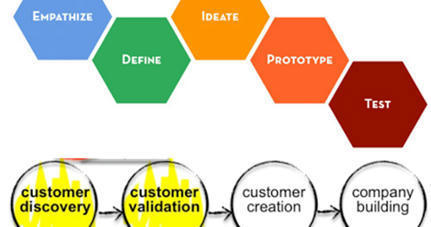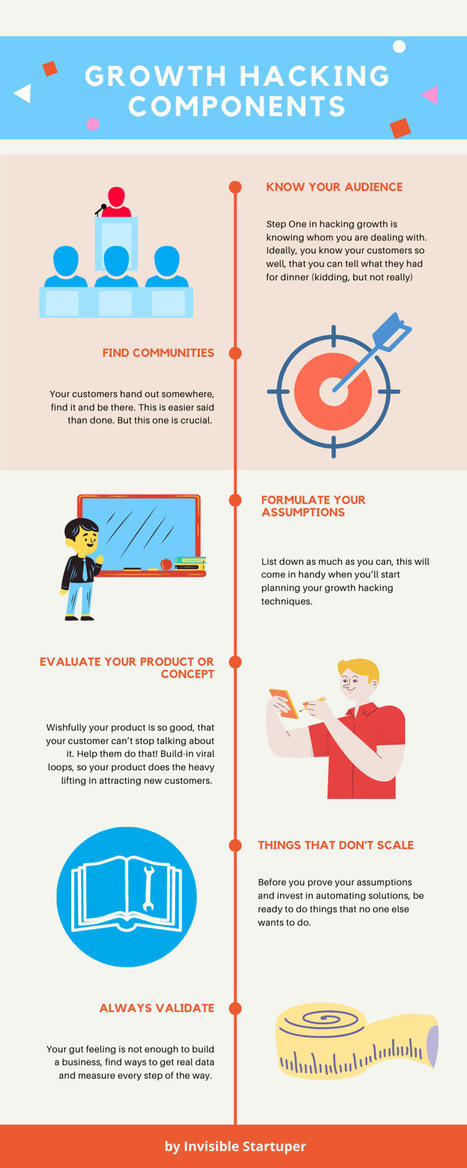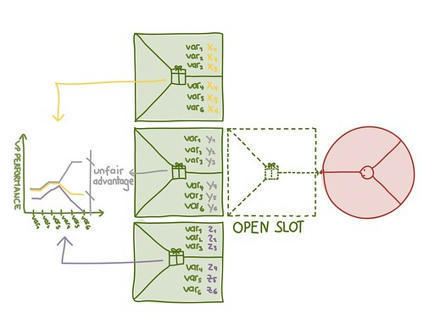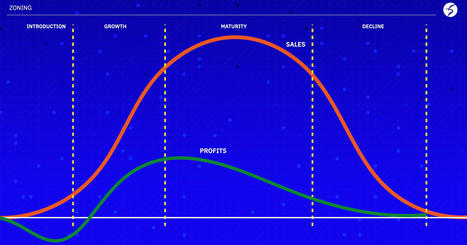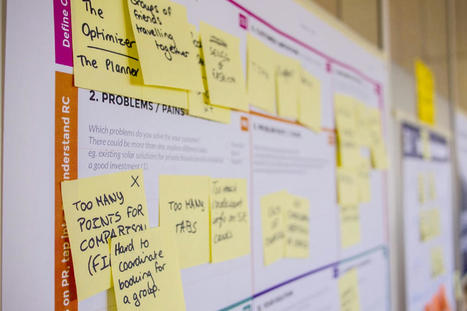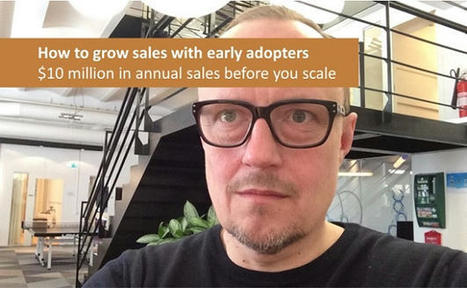 Your new post is loading...
 Your new post is loading...

|
Scooped by
Mickael Ruau
January 22, 2024 3:16 PM
|
Are a product launch and a go-to-market strategy the same thing? The answer to that question is a clear no. And we're going to share with you what the differences are.
A soft product launch is part of a go-to-market strategy before you imagine them as two separate elements within the grand scheme. The first commercialisation phase is where a small group pays for your solution. At this stage, you are not actively promoting your product.
Your soft product launch is the first step to creating and executing your go-to-market strategy. A GTM is a sprint where you'll test about 3-4 different channels to identify the right ones, which will be the ones with the best ROI and the best volume.

|
Scooped by
Mickael Ruau
February 26, 2022 2:47 AM
|
Développement client, ou comment réduire les risques d’échec des startups! Source: Betagroup Co-Working Space du livre de Steve Blank "4 steps to Epiphany"

|
Scooped by
Mickael Ruau
February 19, 2022 2:34 AM
|
“Quel est votre traction?” Une question presque inévitable dans l’écosystème startup. Pour y répondre honnêtement, et comme toujours en startup, le contexte de votre business vous aidera à définir la meilleure métrique qu’il faudra mettre en avant. Preuve tangible que votre startup prend son envol, la mesure de cette métrique et son amélioration seront la preuve tangible de votr

|
Scooped by
Mickael Ruau
February 17, 2022 1:53 AM
|
Formulation good research questions seems to be very hard. We prefer "open dialogue" methods above questionnaires, especially when you are not sure what to ask.

|
Scooped by
Mickael Ruau
February 12, 2022 2:27 AM
|
If you confuse Lean with Cheap when you do find a repeatable and scalable sales model, you will starve your company for resources needed to scale. Customer Development (and Lean) is about continuous customer contact/iteration to find the right time for execution.
The Customer Development Venture Pitch
At this point I often hear entrepreneurs say, “We don’t have the money to scale. We’ve been running on small investments from friends and family or angels. How do we raise the big bucks?”
How to raise real money with a Customer Development presentation in the next post.

|
Scooped by
Mickael Ruau
February 11, 2022 1:26 AM
|
The way that the FAANG companies use metrics to build products is vital to their success. They invest an army of people and homegrown tools to pull it off. My last article, Balancing short-term and…

|
Scooped by
Mickael Ruau
February 5, 2022 6:57 AM
|
Quand le produit est lancé en commercialisation, Anaïs en voit déjà les limites et commence à penser à une V2 et une ouverture de capital. Elle prend quelques contacts dans les fonds d’investissement mais n’arrive pas à trouver leur adhésion : à cette époque les données du marché sont plutôt pessimistes malgré son début de traction (une vingtaine de clients dans le 1er mois).
Elle écume toutes les aides possibles pour le projet, puis sur les conseils du Réseau entreprendre et d’Atlanpole décide finalement, mais un peu à contrecœur, la transformation de BeApp en agence.

|
Scooped by
Mickael Ruau
January 29, 2022 3:42 AM
|
How much of your time as an entrepreneur or member of a young company should be focused on acquiring customers versus developing your product or service?
According to Gabriel Weinberg and Justin Mares, the answer is 50%—split time evenly between building your product or service and bringing i

|
Scooped by
Mickael Ruau
January 28, 2022 12:47 PM
|
Interestingly enough, the article written by Steve Blank does intend to draw a clear line dividing those two approaches. The two main arguments supporting this division, according to Blank, are based on the different features of a startup compared to those of a established company, and they are as follows:
- A startup has a pressure and a sense of urgency (so that they don't run out of resources before validating their innovative proposal, which would imply to close that emerging company and to fire the team) much more noticeable than in the case of an established company that wants to explore an innovative project. This makes innovation processes (and, among them, learning from customers) to be different in one case or the other.
- Customer Development was conceived by Blank thinking about startups launched by "visionaries" that startup with a solid idea about a product and search for customers and markets wanting it. Thus, they have that pressure and sense of urgency to find those customer segments (and reaching product/market fit) before running out of resources. Design Thinking (at least according to Blank) is not devised thinking of an entrepreneur's vision of the product he/she wants to build. Instead, it focuses on "searching for problems/needs" using a process that attempts to reduce risk through learning and iterative refinement using prototypes.

|
Scooped by
Mickael Ruau
January 8, 2022 2:50 AM
|
When Dropbox launched, a number of cloud storage competitors with deep pockets already existed: Google Drive, iCloud, AWS, Carbonite, to name a few. To get their product off the ground, Dropbox had to be different. And simple to understand.

|
Scooped by
Mickael Ruau
December 25, 2021 3:21 AM
|
Growth hacking usually refers to a set of strategies focused solely on growth. It normally refers to some creative and low-cost ways to acquire and retain customers. I think of Growth Hacking as a…

|
Scooped by
Mickael Ruau
December 21, 2021 12:51 AM
|
In this article, you will understand the customer discovery process, its four Phases through the Customer development model. Read More..

|
Scooped by
Mickael Ruau
December 18, 2021 2:14 AM
|
Learn how the Value Proposition Designer Canvas can help a business map, analyze, test, and pivot their company’s value proposition.
|

|
Scooped by
Mickael Ruau
December 23, 2023 2:48 PM
|
Product Market Fit - De la phrase de prototypage à la phase de croissance : 4 étapes pour imaginer et construire votre produit en minimisant les risques.

|
Scooped by
Mickael Ruau
February 25, 2022 1:00 AM
|
The Start-up Owners Manual
This near-encyclopedic guide unlocks the secrets to startup success - walking you, step-by-step, through the tested and proven Customer Development process created by startup expert Steve Blank. Whether you're launching a physical channel startup or one that will sell through web/mobile channels, on these pages, you'll learn how to:
Use the Customer Development method to bring your business idea to life
Conduct your search for a scalable, profitable business model
Incorporate the Business Model Canvas as the organizing principle for startup hypotheses
Find Product-Market fit
Get, Keep and Grow customers
Fuel growth with metrics that matter
Avoid the 9 deadly sins startups commit most often. The Startup Owner's Manual lays out the best practices, lessons and tips that have swept the startup world, offering a wealth of proven advice and information for entrepreneurs of all stripes.
Quick links:
Video: Steve Blank on entrepreneurship 1, 2, 3, 4 and 5
Video: Steve Blank, the start-up owners manual
Slides: Steve Blank, the nine deadly sins of start-ups
Paper: Steve Blank, the nine deadly sins of start-ups

|
Scooped by
Mickael Ruau
February 18, 2022 1:41 AM
|
Steve Blank's presentation on Customer Development. Uploaded by venturehacks.com

|
Scooped by
Mickael Ruau
February 14, 2022 1:33 AM
|
This post describes a way of tracking growth experiments using Google Sheets.
You can find all of the templates in this Google Folder. The growth experiments belong to a method that is strongly based on Brian Balfour’s “How to build a Growth Machine” article. The original on www.coelevate.com no longer exists but this one KissMetrics article seems to contain most of the important points. In my opinion, Balfour’s writing and thinking is some of the smartest in the business.

|
Scooped by
Mickael Ruau
February 12, 2022 1:38 AM
|
The truth is that many startups make the same mistake of thinking if something doesn’t work, it must be everything, or they just guess the wrong reason why their business is not working. The truth is, any part of a customer’s experience can influence them. Here are some other metrics to consider, my own 5C Scorecard:
Customer Numbers A simple, binary index, set and measured for each period, provides visibility, clarity and simplicity of your North Star.
Conversion Rate to be a very telling KPI in that it reveals a combination of the company’s ability to sell its products to its customers and the customers’ desire for the product. It is particularly instructive to track and review Conversion Rate over time and regularly run experiments to improve.
Customer Acquisition Cost (‘CAC’) CAC is the unit cost of spend on sales and marketing, on average, to acquire a new customer. This tells us about the efficiency and effectiveness of our marketing efforts, although it’s more meaningful when combined with other metrics detailed below, and when measured over time.
Customer Retention Rate indicates the percentage of paying customers who remain paying customers during a given time period. The converse to retention rate is Churn (or Attrition), the percentage of customers you lose in a given period. When you see high retention rates over an indicative time period, you know you have a sticky product that is keeping customers happy. This is also an indicator of capital efficiency.
Customer Lifetime Value (‘CLTV’) is the measurement of the net value of an average customer over the estimated life of the relationship. Improving the ratio of CLTV/CAC is critical to building a sustainable company.
There is also one financial metric you need to keep a track on at this stage:
Cash Burn This is simply the net cashflow per month and is critical to the survival of any startup. Runway is the measure of the amount of time until have in terms of cash, expressed in terms of months.
Short Runways cause entrepreneurs to be myopic and removes the liberty to tweak and iterate when necessary. It also forces them to focus on the next fundraising round instead of on growing the business. It’s a separate discussion from this blog, but fund raising should be focused on milestones, not the runway.

|
Scooped by
Mickael Ruau
February 10, 2022 1:06 AM
|
Overview of steps
Complete the value proposition canvas
Build the simplest possible version of MVP
Test the MVP with real users

|
Scooped by
Mickael Ruau
February 5, 2022 3:32 AM
|
Learn what it takes to build a successful startup using the Customer Development process, where entrepreneurs "get out of the building" to gather and iterate on feedback.

|
Scooped by
Mickael Ruau
January 29, 2022 2:28 AM
|
Customer Discovery
At this step, the team should be focused on relatively open-ended discovery, learning who their customer is and what’s actually on their A-list in your area of interest. I would consider moving on when you have a clear view of an early market persona and problem scenario and a working hypothesis about a value proposition you want to test. At this point, you’re at the end of what you can learn from open-ended questions and you need to be able to observe how your hypothetical customer reacts to an MVP (a la Lean Startup).
Customer Validation
At the beginning of this phase, you are still (hopefully) pre-product in the sense of having invested in actual, working software. You are using techniques from Lean Startup to if and how your customer is motivated with regard to your hypothetical problem/solution(proposition) fit and then your specific product/market fit.
Customer Creation
Here you are taking what might be called an early product/market fit and seeing if how you can apply growth hacking recipes to scale it. You’re not exactly popping the cork yet- you’re still grinding through growth experiments to see if you can expand to a large market.

|
Scooped by
Mickael Ruau
January 28, 2022 9:31 AM
|
Customer Development was a way to quickly search outside the building for a profitable business model when customer needs are unknown. Eric observed that an Agile Development model was the right match for engineering to build a product when the initial feature set was unknown. The sum of solving for both unknown customer needs and unknown features became the Lean Startup.
Topological Homeomorphism
This year I decided the Customer Development class needed to morph into the Lean Startup class. We needed to teach both Customer Development and Agile methodologies. I drafted Eric to help teach the class and we began to transform the curriculum.

|
Scooped by
Mickael Ruau
January 7, 2022 4:48 AM
|
Lean LaunchPad is an entrepreneurship methodology created by Steve Blank to test and develop business models based on querying and learning from customers. It is based on the scientific method and combines experiential learning with the three building blocks of a successful lean startup: Alexander Osterwalder's " Business Model Canvas", Steve Blank's " Customer Development Model", and Agile Engineering.
Lean LaunchPad is an entrepreneurship methodology created by Steve Blank to test and develop business models based on querying and learning from customers. It is based on the scientific method and combines experiential learning with the three building blocks of a successful lean startup: Alexander Osterwalder's "Business Model Canvas", Steve Blank's "Customer Development Model", and Agile Engineering.
Students of Lean LaunchPad propose and immediately test business hypotheses. They get out of the building to talk with prospective customers and partners, using this customer feedback acquired in these interviews to refine their product or service; ensure their product or service meets a customer need or solves a customer problem; and validate that they have created a repeatable, scalable business model.
Methodology
Lean LaunchPad pedagogy combines three elements: a Flipped Classroom, Experiential learning and Team-based learning. During the course, students interview potential customers in order to validate or invalidate their hypotheses, as expressed in the Business Model Canvas. Students listen to recorded lectures and presentations before each class, and use class time to present what they learned from customer interviews the previous week. Students present their findings which creates the basis for discussion, critiques, and brain-storming by both professors and students.[1]
As of 2021, the Lean LaunchPad has been taught in more than 300 universities worldwide to over 20,000 teams. More than 300,000 people have signed up for a free online version of the class[citation needed].

|
Scooped by
Mickael Ruau
December 25, 2021 3:10 AM
|
If you want to learn why and how to grow sales with early adopters as customers, before you cross the chasm, you’ve come to the right place

|
Scooped by
Mickael Ruau
December 18, 2021 2:23 AM
|
|
 Your new post is loading...
Your new post is loading...
 Your new post is loading...
Your new post is loading...











